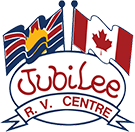WINTERIZING YOUR RV: USING ANTIFREEZE
 We’ve reached the colder part of the year, and while that means the holidays are in full swing, most of us will be putting away our RVs for the winter. Without a doubt, there are those who will camp all winter long, but we here at Jubilee RV Centre wanted to provide some quick tips for our patrons who want to stay in during the cold months
We’ve reached the colder part of the year, and while that means the holidays are in full swing, most of us will be putting away our RVs for the winter. Without a doubt, there are those who will camp all winter long, but we here at Jubilee RV Centre wanted to provide some quick tips for our patrons who want to stay in during the cold months
Above all, don’t just put your RV in park and walk away for three or more months. There are particular steps you’ll need to take to make sure your RV is ready for storage during the cold months, including adding antifreeze to your water system to make sure excess water doesn’t freeze, expand, and then damage the internal workings of your RV.
We’ve listed out the basics below to get you started. If you’re still unsure, stop by Jubilee RV Centre to talk with our RV experts about best antifreeze practices and other important winterization steps. We’re located in Kamloops, British Columbia, proudly serving the areas of Vancouver, Kelowna, Prince George, and Vernon, British Columbia.
DRAIN THE WATER SYSTEM
This includes all your water systems, such as freshwater tanks, gray and black tanks, and the water heater. If you don’t have a flushing system for your gray and black tanks, clean them out yourself with a wand or use a product designed to flush out and clean your system. These tanks should also be properly lubricated.
OPEN ALL FAUCETS
Open all cold and hot water faucets, as well as the toilet valve and outside shower to allow water to drain. Also, open all the drain lines and use a water pump to force every last drop of water out of your RV. Once you’re sure your RV is drained, recap and close all drains and faucets.
BLOW OUT THE LINES
After draining the water, attach a blow out plug to the City Water Intake. Apply pressure to push out water remaining inside. This is not an essential step, but it helps ensure there is no water to dilute the antifreeze.
BYPASS THE WATER HEATER
This is an important step. If you do not have a by-pass kit installed, the water heater will fill up with antifreeze before it can properly move through your water supply, potentially costing you gallons of antifreeze. Your water heater may have a specific bypass method, but no matter what you do, make sure this step happens.
INSTALL A WATER PUMP CONVERTER KIT
You can either install a water pump converter kit, or disconnect the inlet side of the water pump and insert a piece of clear tubing. This is how you’re going to get the antifreeze into your water supply system.
ADD ANTIFREEZE
Now it’s time to add the antifreeze. As you pump antifreeze through your system, go to the closest faucet and turn on the cold and then the hot water supply until antifreeze comes out. Continue this with each faucet, moving further and further away from your original starting point, and don’t forget the toilets. Flush the toilets until you see antifreeze.
Once the antifreeze has successfully made it through your water system, turn off the water pump and open one faucet to release the pressure. Go back to the side water inlet, remove the screen, and push on the valve with a screwdriver until you see antifreeze. Then replace the screen. Pour a cup-full of antifreeze down each drain and a couple cups down the toilet. Flush the antifreeze into the holding tank. Finally, make sure all the faucets are closed.
Using antifreeze is an essential step to winterizing your RV, but it’s not the only one. Stop by Jubilee RV Centre for additional winterization help. We’re located in Kamloops, British Columbia and welcome all RV owners from the areas of Vancouver, Kelowna, Prince George, and Vernon, British Columbia.

